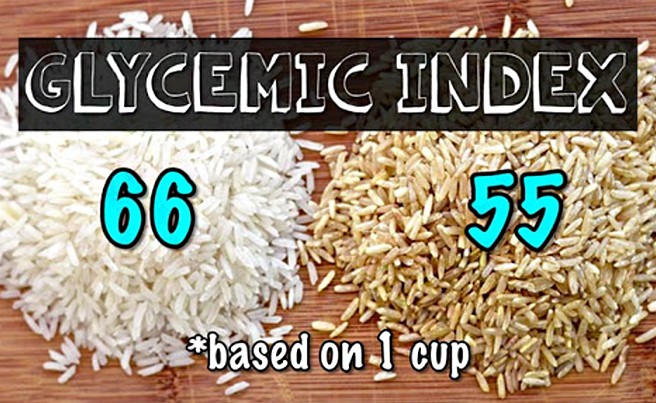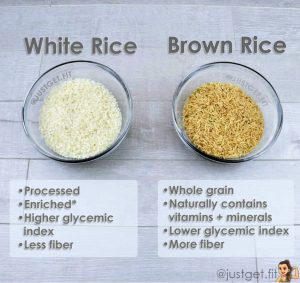In the realm of dietary choices, one debate looms large—brown rice vs. white rice for blood sugar control. Understanding the glycemic index and its implications for people with diabetes or those looking to manage their sugar intake is essential. This comprehensive guide will delve into the impact of brown and white rice on blood sugar levels, allowing you to make informed choices for your well-being.
The Glycemic Index: A Primer
Before we explore the debate, it’s crucial to grasp the concept of the glycemic index (GI).
1. What Is the Glycemic Index?
The glycemic index is a numerical scale that ranks carbohydrates based on how quickly they raise blood sugar levels after consumption. Foods with a high GI are rapidly digested and absorbed, leading to quick spikes in blood sugar. In contrast, low-GI foods are slowly digested and absorbed, causing a more gradual increase in blood sugar levels.

2. The Role of GI in Blood Sugar Control
Understanding the GI of foods is particularly important for people with diabetes and those who aim to manage their sugar intake. Consuming lower-GI foods can help stabilize blood sugar levels and reduce the risk of blood sugar spikes and crashes.
The Brown Rice Advantage
Now, let’s delve into the specifics of brown rice and why it’s considered advantageous for blood sugar control.
1. Low Glycemic Index
Brown rice has a lower GI compared to white rice. This means it causes a slower and more controlled rise in blood sugar levels after consumption.
2. High Fiber Content
The bran layer in brown rice, which is removed in the refining process to make white rice, contains significant amounts of dietary fiber. This fiber slows down the digestion and absorption of carbohydrates, contributing to the lower GI of brown rice.
3. Nutrient Density
Brown rice is more nutrient-dense than white rice, as it retains vitamins, minerals, and antioxidants. These nutrients, particularly magnesium, have a positive impact on blood sugar control.
4. Satiety
Fiber and nutrients in brown rice promote a sense of fullness, reducing the likelihood of overeating and aiding in weight management. Maintaining a healthy weight is vital for blood sugar control.
The White Rice Dilemma
While white rice is widely consumed and appreciated for its taste and texture, it presents challenges for blood sugar control.
1. High Glycemic Index
White rice has a high GI, leading to rapid spikes in blood sugar levels after consumption. This can be problematic for people with diabetes or those aiming to manage their sugar intake.
2. Low Fiber Content
The milling process to make white rice strips away the bran layer, significantly reducing its fiber content. This lack of fiber contributes to the rapid digestion and absorption of carbohydrates.
3. Limited Nutrient Profile
White rice is less nutrient-dense compared to brown rice. It lacks many of the vitamins and minerals that support overall health, including blood sugar control.
4. Less Satiety
White rice may not provide the same level of satiety as brown rice due to its lower fiber content, potentially leading to overconsumption.
Making Informed Choices
To make informed choices for blood sugar control, consider the following tips:
- Portion Control: If you prefer white rice, practice portion control to manage blood sugar levels effectively.
- Pair with Fiber: If you opt for white rice, balance your meal with high-fiber foods like vegetables, legumes, and lean proteins to offset its high GI.
- Combine Both: Mixing brown and white rice is an option that combines the health benefits of brown rice with the taste and texture of white rice.
- Consider Alternatives: Explore alternative grains like quinoa, barley, or bulgur, which may have lower GIs and additional nutritional benefits.
- Monitor Blood Sugar: If you have diabetes, regularly monitor your blood sugar levels to understand how different foods affect you personally.
Image By: https://justget.fit/wp-content/uploads/2017/10/white-rice-vs-brown-rice-862×814.jpg
Conclusion
The brown rice vs. white rice debate for blood sugar control is an important one. Understanding the glycemic index and the impact of different rice varieties on blood sugar levels empowers you to make informed dietary choices. While white rice may be a culinary favorite, brown rice’s lower GI, higher fiber content, nutrient density, and satiety make it a superior choice for blood sugar control. Whether you choose brown rice exclusively, opt for a mix of both, or explore alternative grains, your decision can have a profound impact on your blood sugar levels and overall well-being. Make choices that align with your health goals and savor the benefits of controlled blood sugar.











